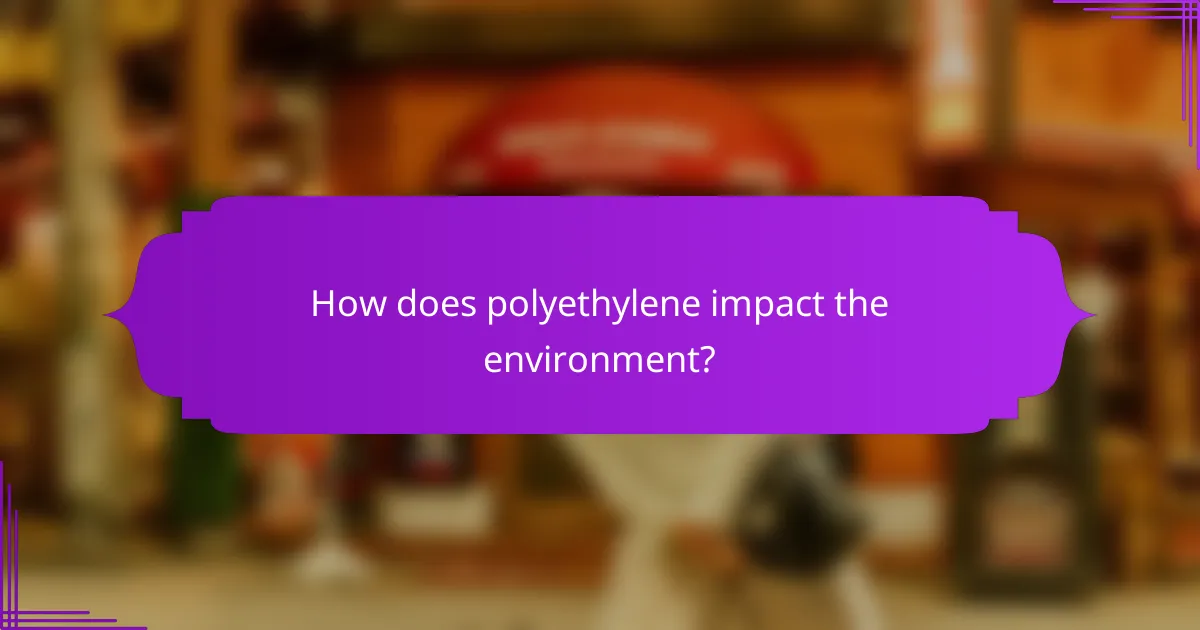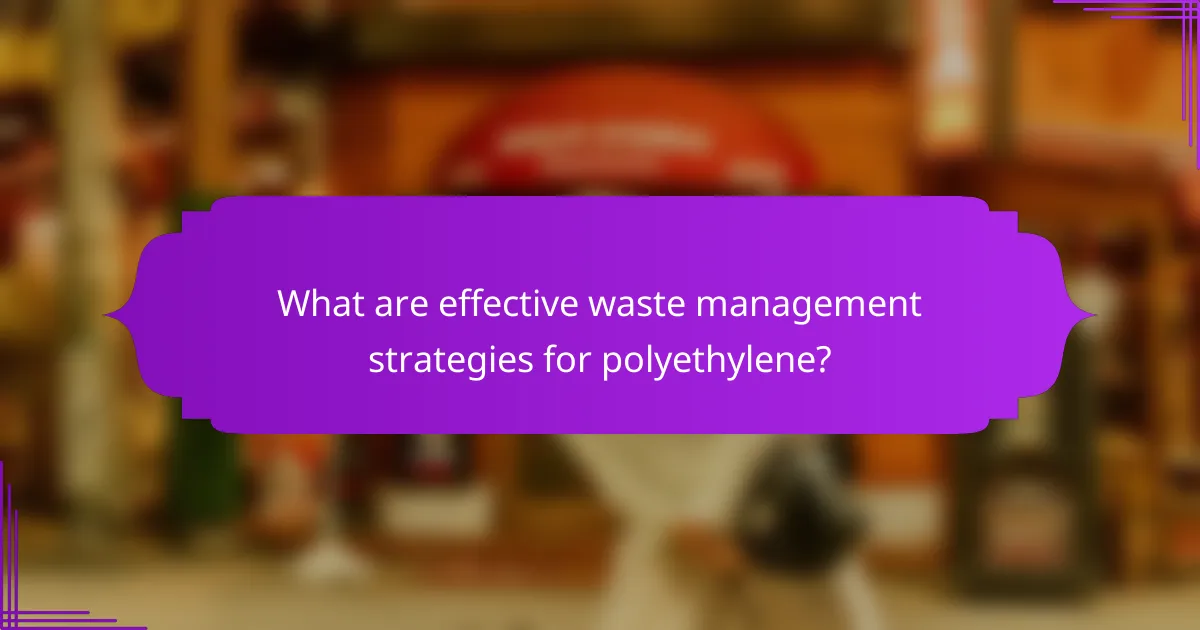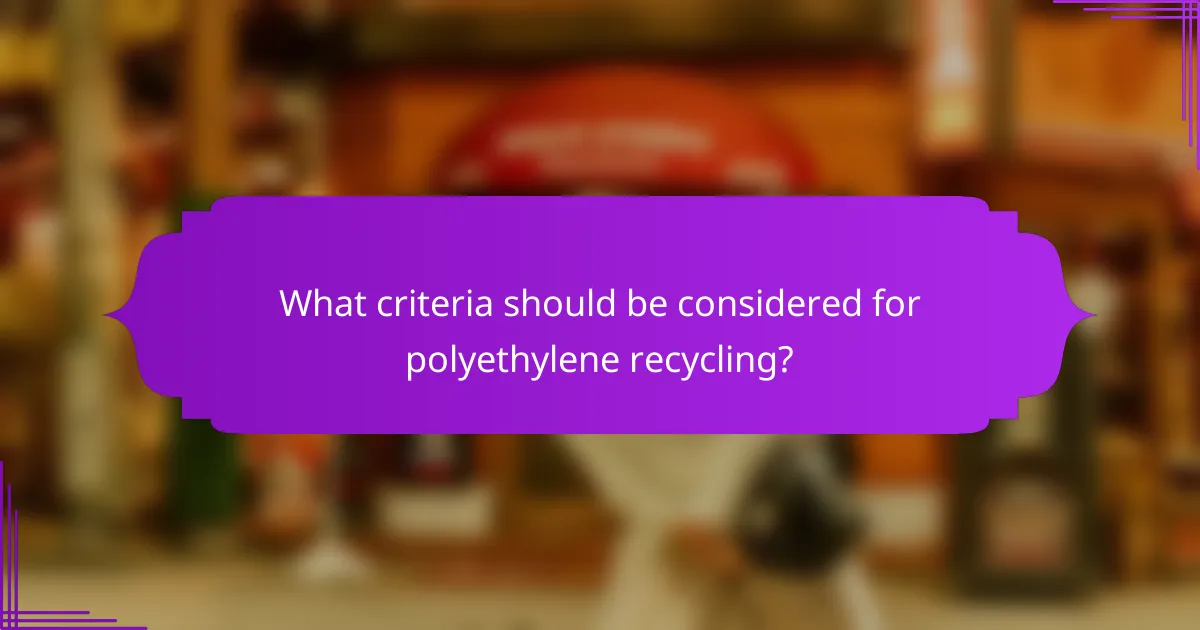Polyethylene, a widely used plastic, presents significant recycling challenges due to contamination, insufficient facilities, and economic viability issues. Its environmental impact is profound, contributing to carbon emissions, marine pollution, and substantial landfill waste. Addressing these challenges requires innovative waste management strategies and community engagement to improve recycling rates and reduce ecological harm.

What are the recycling challenges of polyethylene in New Zealand?
The recycling challenges of polyethylene in New Zealand include contamination issues, a lack of recycling facilities, and economic viability concerns. These factors hinder effective recycling efforts and contribute to the environmental footprint of polyethylene waste.
Contamination issues
Contamination is a significant barrier to polyethylene recycling. When polyethylene products are mixed with other materials or contaminated with food residues, they become difficult to process. This often leads to entire batches being rejected, which increases waste and reduces recycling rates.
To mitigate contamination, consumers should rinse and clean polyethylene items before disposal. Proper sorting at the household level can improve the quality of recyclables and enhance the efficiency of recycling facilities.
Lack of recycling facilities
New Zealand faces a shortage of specialized recycling facilities capable of processing polyethylene. Many regions lack the infrastructure needed to handle this type of plastic, resulting in limited recycling options for consumers. This situation forces many polyethylene products into landfills instead of being recycled.
Expanding recycling facilities and investing in technology could help address this issue. Local governments and businesses can collaborate to create more accessible recycling points, encouraging higher participation rates among residents.
Economic viability
The economic viability of recycling polyethylene is often challenged by fluctuating market prices for recycled materials. When the cost of collecting and processing polyethylene exceeds the market value of the recycled product, recycling becomes less attractive for operators.
To improve economic viability, initiatives such as deposit return schemes or government subsidies for recycling programs could be beneficial. These measures can incentivize recycling and help create a more sustainable market for recycled polyethylene in New Zealand.

How does polyethylene impact the environment?
Polyethylene significantly affects the environment through its carbon footprint, contribution to marine pollution, and the volume of waste it generates in landfills. Its widespread use and durability lead to long-lasting ecological challenges that require effective waste management strategies.
Carbon footprint
The production of polyethylene contributes to greenhouse gas emissions, primarily through the extraction and processing of fossil fuels. Estimates suggest that the carbon footprint of polyethylene production can range from several hundred to over a thousand kilograms of CO2 per ton of plastic produced.
Reducing the carbon footprint involves adopting more sustainable practices, such as using renewable energy sources in manufacturing and improving energy efficiency. Consumers can also help by choosing products made from recycled polyethylene, which generally have a lower carbon impact compared to virgin materials.
Marine pollution
Polyethylene is a major contributor to marine pollution, with millions of tons entering oceans each year. This plastic can break down into microplastics, which are harmful to marine life and ecosystems.
To mitigate marine pollution, it is crucial to improve waste management systems and promote recycling initiatives. Individuals can reduce their impact by minimizing single-use plastic consumption and participating in local clean-up efforts.
Landfill contributions
Polyethylene waste contributes significantly to landfill volumes, as it can take hundreds of years to decompose. In many regions, polyethylene makes up a substantial portion of the plastic waste found in landfills, exacerbating space and environmental issues.
To address landfill contributions, consumers should prioritize recycling and proper disposal methods. Engaging in community recycling programs and supporting legislation aimed at reducing plastic waste can help alleviate the burden on landfills.

What are effective waste management strategies for polyethylene?
Effective waste management strategies for polyethylene include community recycling programs, extended producer responsibility (EPR), and innovative recycling technologies. These approaches aim to reduce plastic waste, enhance recycling rates, and minimize environmental impact.
Community recycling programs
Community recycling programs play a crucial role in managing polyethylene waste by providing accessible collection points and educational resources. Local governments often collaborate with waste management companies to set up drop-off centers and curbside pickup services.
To maximize participation, these programs should focus on clear communication about what materials are accepted and how to prepare them for recycling. Engaging community members through workshops and events can also foster a culture of recycling.
Extended Producer Responsibility (EPR)
Extended Producer Responsibility (EPR) shifts the responsibility of waste management from consumers to producers. Under EPR schemes, manufacturers are required to take back their products and packaging, including polyethylene, at the end of their life cycle.
This approach incentivizes companies to design products that are easier to recycle and reduces the overall volume of plastic waste. Countries like Germany and Sweden have successfully implemented EPR policies, leading to higher recycling rates and lower environmental footprints.
Innovative recycling technologies
Innovative recycling technologies, such as chemical recycling and advanced sorting systems, are transforming how polyethylene waste is processed. Chemical recycling breaks down plastics into their original monomers, allowing for the creation of new, high-quality products.
Advanced sorting technologies, including AI-driven systems, enhance the efficiency of separating polyethylene from other materials, increasing the overall recycling yield. Investing in these technologies can significantly improve the sustainability of polyethylene waste management efforts.

What criteria should be considered for polyethylene recycling?
Key criteria for polyethylene recycling include material purity and market demand for recycled products. These factors significantly influence the effectiveness and viability of recycling processes.
Material purity
Material purity refers to the cleanliness and quality of the polyethylene being recycled. Contaminants such as food residues, labels, and other plastics can hinder the recycling process and reduce the quality of the final product. Ensuring that polyethylene is free from impurities is crucial for achieving high-quality recycled materials.
To improve material purity, consumers should rinse containers and remove labels before disposal. Recycling facilities often have specific guidelines for acceptable materials, so adhering to these can enhance the recycling outcome.
Market demand for recycled products
Market demand for recycled polyethylene products plays a vital role in determining the success of recycling initiatives. If there is limited demand for recycled materials, it can lead to lower prices and reduced incentives for recycling. Industries that utilize recycled polyethylene must be willing to invest in these materials to create a sustainable market.
To foster demand, companies can promote the benefits of using recycled polyethylene, such as lower environmental impact and potential cost savings. Additionally, government policies and incentives can help stimulate the market for recycled products, encouraging more businesses to incorporate them into their supply chains.

What are the future trends in polyethylene recycling?
Future trends in polyethylene recycling focus on improving efficiency and reducing environmental impact. Innovations in technology and policy are driving the development of more sustainable practices and alternatives.
Biodegradable alternatives
Biodegradable alternatives to polyethylene are gaining traction as consumers and manufacturers seek environmentally friendly options. Materials such as polylactic acid (PLA) and polyhydroxyalkanoates (PHA) offer similar functionalities while breaking down more easily in natural environments.
These alternatives can be integrated into existing production processes, but they often come at a higher cost. Companies must weigh the benefits of sustainability against the potential increase in production expenses.
Advanced recycling methods
Advanced recycling methods, such as chemical recycling, are emerging as viable solutions to polyethylene waste. These processes break down plastics into their original monomers, allowing for the creation of new plastic products without degrading quality.
While traditional mechanical recycling is limited by contamination and degradation, advanced methods can handle a wider range of plastic types. However, they require significant investment in technology and infrastructure, which can be a barrier for many facilities.
Policy changes and regulations
Policy changes and regulations are crucial in shaping the future of polyethylene recycling. Governments worldwide are implementing stricter guidelines on plastic production and waste management, encouraging companies to adopt more sustainable practices.
For instance, the European Union has set ambitious targets for recycling rates and the use of recycled materials in new products. Compliance with these regulations can drive innovation but may also increase operational costs for businesses that need to adapt to new standards.


